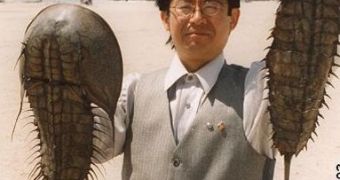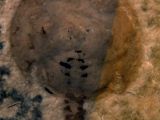These weird creatures are called horseshoe crabs, but they have nothing to do with the actual crabs. They are not crustaceans, but related with the extinct trilobites, sea scorpions (that could reach 3 m or 10 ft in length) and with the living scorpions.
They are amongst the largest living arthropods and are considered living fossils. That's because the oldest horseshoe crab known is a 350-million-year-old fossil from the Carboniferous period, and it's exactly like the actual living species. Fossils also came from the Jurassic, the middle age of the dinosaurs (about 200 million years ago), and were similar to the living species as well. Now, a Canadian team has found an even older genus of horseshoe crab, in 445-million-year-old rocks from the Ordovician, in central and northern Manitoba.
Lunataspis aurora had only 1.5 in (4 cm) from head to tail-tip, a dwarf compared to the modern species, which are about 20 in (50 cm).
"We do not know if the fossils were small because they were simply young animals or because Lunataspis just didn't grow any bigger," said co-author David Rudkin of the Royal Ontario Museum, in Canada, whose team described the fossil in the journal "Paleontology."
The fossils preserved patches of the animals' exoskeleton and their compound eyes. As horseshoe crabs wear a flexible chitin exoskeleton made of a material more prone to degradation (not like the hard crust of the crabs), fossils of horseshoe are rare.
"We wouldn't necessarily have expected horseshoe crabs to look very much like the modern ones, but that's exactly what they look like. This body plan that they've invented, they've stayed with it for almost a half a billion years," Rudkin told LiveScience.
"They've survived almost unchanged up until the present day, whereas lots of other animals haven't. The horseshoe crab, the lowly little animal that crawls out of the sea every once in a while to mate, it's survived for at least 445 million years in more or less the same form. Understanding how horseshoe crabs adapted to their ecological niche so early and then weathered natural crises will give scientists broader insights about how ocean ecosystems changed over time," said Rudkin.

 14 DAY TRIAL //
14 DAY TRIAL // 
